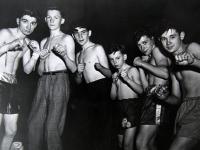Answer: The Lighthouse, Inc.
Philadelphia’s Kensington was hard hit by a financial depression at the turn of the 19th century, and alcoholism and homelessness were rampant throughout the industrial neighborhood. At the time, Kensington had more than 100 saloons in a five-block radius. In 1893, Esther Warner Kelly frequently traveled through Kensington to visit her brother, who worked as a medical intern at the Episcopal Hospital at the corner of Front and Lehigh Streets. Kelly was inspired to improve the neighborhood and began holding men’s Bible classes at the hospital two nights a week. These classes provided an alternative to the saloons as a place to gather and socialize.
Kelly’s classes proved popular and she soon had to find a larger meeting space. With help from family and the Union Benevolent Association, Kelly acquired a three-story building at 140 West Lehigh Avenue, to serve as a social club for the men of Kensington. By 1895, the organization was operating as the Lighthouse, and it was incorporated under that name in 1901.
Since its formation, the Lighthouse has evolved to meet the needs of the community. During its early years, programs focused on unemployment relief, public baths, savings banks, and tuberculosis education and prevention. In the 1920s, the Lighthouse directed more of its efforts toward recreational programs and services including its library, gymnasium, and pools. It helped establish the nation’s first Meals on Wheels program in the 1950s and became devoted to causes such as women’s rights, children’s education, and community development. The Lighthouse continues to serve the community from its facilities located at 152 West Lehigh Avenue in Philadelphia.
HSP has an extensive collection of the Lighthouse's records (#1970) dating from 1893 to 2000. It contains a wide range of materials covering most aspects of the organization's history through everything from administrative and financial files to membership records and photographs.
Image: Boys boxing at the Lighthouse club, undated

